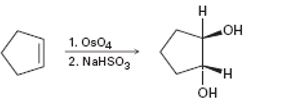
a)

Interpretation:
The reaction given has a serious drawback. The potential problem in it is to be explained.
Concept introduction:
The addition of hydrogen halides to unsymmetrical
To explain:
The potential problem in the reaction given.
b)

Interpretation:
The reaction given has a serious drawback. The potential problem in it is to be explained.
Concept introduction:
Alkenes undergo hydroxylation when treated first with OsO4 and then with NaHSO3. The reaction occurs with syn stereochemistry. Both –OH groups add to the double bond from the same face to give a cis-1,2-
To explain:
The potential problem in the reaction given.
c)

Interpretation:
The reaction given has a serious drawback. The potential problem in it is to be explained.
Concept introduction:
During ozonolysis ozone adds to the double bond in an alkene to give an ozonide. The ozonide on treatment with Zn in the presence of acid gets cleaved to yield carbonyl compounds as products. During the reaction each carbon in the double bond gets an oxygen atom.
To explain:
The potential problem in the reaction given.
d)

Interpretation:
The reaction given has a serious drawback. The potential problem in it is to be explained.
Concept introduction:
Alkenes can be hydrated using hydroboration-oxidation reaction. The reaction occurs with syn stereochemistry following anti markovnokov regiochemistry. The addition of both H and OH takes place from the same face of the double bond. The boron and hence the –OH group gets attached to less highly substituted carbon.
To explain:
The potential problem in the reaction given.
Want to see the full answer?
Check out a sample textbook solution
Chapter 8 Solutions
Organic Chemistry
- In planning the synthesis of one compound from another, it's just as important to know what not to do as to know what to do. The following reactions all have serious drawbacks to them. Explain the potential problems of each. Just use 1-2 sentences for each. Br (CH3)3COK CH3CH₂OHarrow_forwardBriefly describe the role of this molecule as it relates to bees. Propose Two reasonable syntheses of this molecule from benzene. there are multiple syntheses possible (the first proposed synthesis required twelve steps) HO. OHarrow_forwardPredict the products of this organic reaction: + KOH ? Specifically, in the drawing area below draw the skeletal ("line") structure of the product, or products, of this reaction. (If there's more than one product, draw them in any arrangement you like, so long as they aren't touching.) If there aren't any products because this reaction won't happen, check the No reaction box under the drawing area. Click and drag to start drawing a structure. :arrow_forward
- 5- Does SN2 occur in one step while SN1 occurs in three steps?arrow_forwardPredict the products of this organic reaction: + H₂0 H ? Specifically, in the drawing area below draw the skeletal ("line") structure of the product, or products, of this reaction. (If there's more than one product, draw them in any arrangement you like, so long as they aren't touching.) If there aren't any products because this reaction won't happen, check the No reaction box under the drawing area. Click and drag to start drawing a structure Xarrow_forward2. Given that the organometallic catalyst (C6H5)Co(CO)2 acts to catalyze the following "triyne cyclization) reaction (discovered by Prof. K. Peter C. Vollhardt, who was rumored to throw wild hot tub parties at UC Berkeley). Me Si -C=C- SiMe3+ (CgHs)½Co(CO) , Me,Si Me3Si Give a mechanism for the following reaction.|arrow_forward
- Shown below is a carbocation intermediate in an electrophilic addition reaction of HCl with an alkene. For the conformation shown, select each hydrogen whose bond to carbon is aligned for effective hyperconjugation with the vacant p orbital on the positively charged carbon. Each adjacent carbon will have only one C-H bond so aligned. • Gray = C; white = H; red = 0; blue = N; dark green = Cl; brown =Br; light green =F; purple = I; yellow = S; orange = P. • Double click to select atoms. • You can zoom in and out using the mouse scroll wheel (or pinch to zoom on touch screens).arrow_forwardbläi 5 :Q3: Complete the reactions below 1. heat E+ HB 2. H20 (PPH3)2PDCI2 B(OH)2 Br кон toluene إضافة ملفarrow_forwardN,N-diethyl-m-toluamide (DEET) is the active ingredient in many insect repellent preparations. Following is one of the steps in its synthesis. In the box below draw the structure of the product of this reaction. H3C MgBr 1. CO2 2. H3O+ product • You do not have to consider stereochemistry. • You do not have to explicitly draw H atoms. • Do not include lone pairs in your answer. They will not be considered in the grading. • Draw the Grignard reagent as a covalent magnesium bromide. 90-87 0 + 11 ? n [arrow_forward
- What is true for this reaction? CI4(1) + 4 HCI(g) CH4(g)+ 4 Cl2{g) AHrxn 0 O AHrxn 0; ASrxn 0; ASrxn > 0arrow_forwardN,N-diethyl-m-toluamide (DEET) is the active ingredient in many insect repellent preparations. Following is one of the steps in its synthesis. In the box below draw the structure of the product of this reaction. MgBr H3C 0 ▾ + 1. CO₂ 2. H3O+ • You do not have to consider stereochemistry. • You do not have to explicitly draw H atoms. • Do not include lone pairs in your answer. They will not be considered in the grading. • Draw the Grignard reagent as a covalent magnesium bromide. n [ ]# product ChemDoodleⓇ 28arrow_forwardPleasearrow_forward
 Organic ChemistryChemistryISBN:9781305580350Author:William H. Brown, Brent L. Iverson, Eric Anslyn, Christopher S. FootePublisher:Cengage Learning
Organic ChemistryChemistryISBN:9781305580350Author:William H. Brown, Brent L. Iverson, Eric Anslyn, Christopher S. FootePublisher:Cengage Learning
